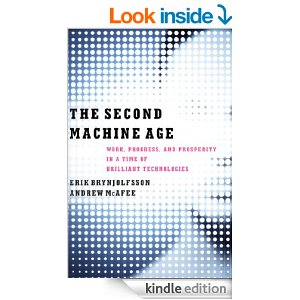The Second Machine Age

Several friends recommended The Second Machine Age: Work, Progress, and Prosperity in a Time of Brilliant Technologies because they know I enjoy learning how current trends and events are likely to shape the future. Authors Erik Brynjolfsson and Andrew McAfee are respected thinkers, so it seemed a good bet.
Sadly, I’m disappointed. The writing is fine and the topics are clear, but it all felt a bit behind the curve. Most of the cutting edge examples were nothing new to me. Nor do I think they were new to most informed people. Google self-driving cars are fascinating, but if you live in the Bay Area you’ve probably seen them fairly often. IBM’s Watson winning Jeopardy is old news. And 3D printing using metals and other substances is hardly cutting edge. Even the conversation about how to measure GDP is nothing new.
The premise of the book is great: we are entering into a huge new era of creativity and progress (at least to the degree more knowledge is progress). The story of the rice on the chessboard (though often used by all technology types) applies well to the trends we are seeing today. So the core ideas of the book are great and important to understand.
I just couldn’t get past the examples they use of cutting edge applications. Feels like I’ve been reading about them for years (or seeing them, as with the Google car).
So then it struck me. You know who recommended the book to me? People who do not live in or near Silicon Valley. My East Coast friends, or European friends. New York based media were really high on the book. That’s probably who buys the Executive Summary of the book too.
I should know better. Want to learn about cutting edge activities? Just go to a coffee shop in Menlo Park and listen to the conversation at the next table. Don’t read a book recommended by a CNN journalist.


